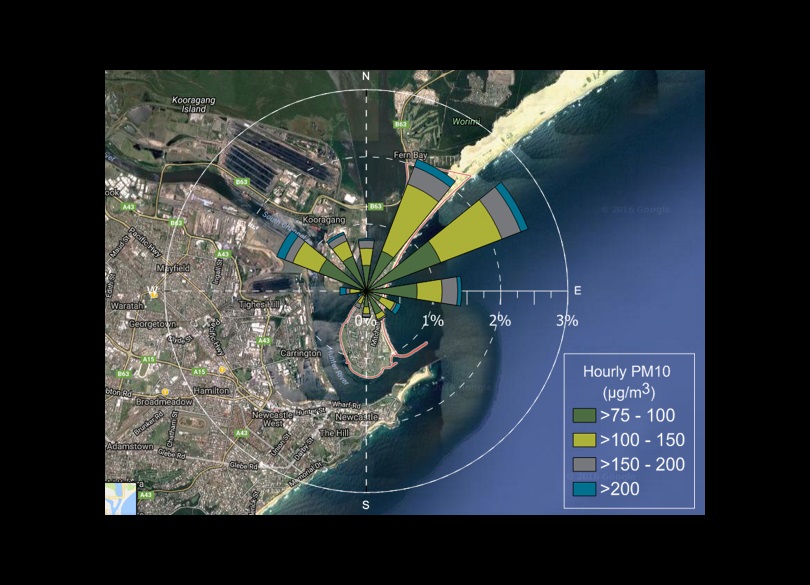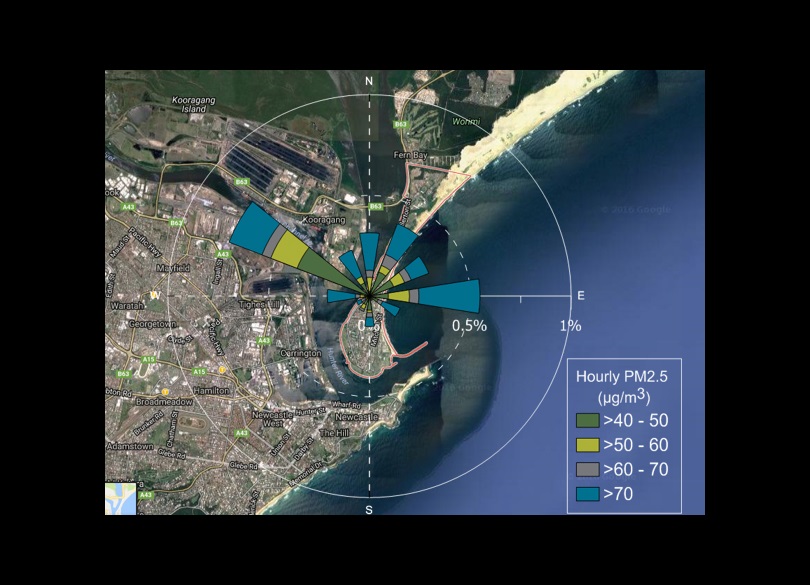The Stockton air quality monitoring station is part of the industry-funded Newcastle Local Air Quality Monitoring Network, focused around the Port of Newcastle. The station is approximately 300 metres from the ocean and 20 metres from Hunter River. Due to its proximity to the coast, high PM10 particle levels recorded at Stockton most often occur under onshore north-easterly winds. The Lower Hunter Particle Characterisation Study found that the largest contribution to PM10 at Stockton was sea salt.
For PM10, in 2019:
- The daily PM10 particle levels at Stockton were over the standard of 50 µg/m3 on 102 days (compared with 64 days in 2018).
- The PM10 annual average was above the standard of 25 µg/m3, reaching 43.6 µg/m3 (compared to 38.7 µg/m3 in 2018).
- Stockton recorded the most days over the standard and the highest annual average in New South Wales.
- Most of the PM10 events at Stockton (83 days, 81.4%) occurred in the warmer months January to March and October to December, when onshore winds predominate. The October to December months were also greatly affected by extensive bushfire smoke during the bushfire emergency period.
- Elevated hourly PM10 levels (>75 µg/m3, an indicative level as there are no standards for hourly PM10) occurred 11.5% of the time over the year, as shown in the PM10 pollution rose below. These elevated hourly PM10 levels occurred under:
- onshore easterly winds 59% of the time (6.8% total time for the year), indicating the potential contribution of sea salt
- north-west winds 18% of the time (2.1% total time for the year).
For PM2.5 in 2019:
- The daily PM2.5 particle levels at Stockton were over the standard of 25 µg/m3 on 27 days (compared with 1 day in 2018).
- The PM2.5 annual average was above the standard of 8 µg/m3, reaching 13.0 µg/m3 (compared to 10.0 µg/m3 in 2018).
- Most of the PM2.5 events at Stockton (26 days, 96.3%) occurred from October to December, during the bushfire emergency period.
- Elevated hourly PM2.5 levels (>40 µg/m3, an indicative level as there are no standards for hourly PM2.5) occurred 3.3% of the time over the year, as shown in the PM2.5 pollution rose below. These occurred under north-west winds 28% of the time (0.9% of time for the year).
Stockton particle levels were greatly affected by extensive bushfire smoke from late spring during the bushfire emergency period, in common with particle levels at other stations in Newcastle and the Local Hunter. There were 35 days over the daily PM10 standard at Stockton that were affected by bushfire smoke in 2019, with most of these (31 days) from 29 October to 31 December.
In addition, elevated particle levels in the region were affected by the long-range transport of dust from drought-affected regions in the west and north-west of the State. There were 13 days over the daily PM10 standard at Stockton that were affected by dust.
Local industrial sources also contribute to particle levels at Stockton, under north-west winds. The Lower Hunter Particle Characterisation Study found that Stockton PM2.5 levels in winter, under north-west winds, were influenced mainly by direct emissions of ammonium nitrate particles from industry, located approximately 1 kilometre to the north-west, on Kooragang Island.
Hourly ammonia (NH3) levels were below the assessment goal of 46 pphm at Stockton throughout 2019. The maximum hourly NH3 level was 20.3 pphm, recorded on 29 August 2019. The annual average ammonia was 1.2 pphm.
For more information on seasonal air quality at Stockton, refer to the Newcastle seasonal newsletters.

Stockton hourly PM10 levels above 75 µg/m3 in relation to wind direction – 2019.

Stockton hourly PM2.5 levels above 40 µg/m3 in relation to wind direction – 2019.